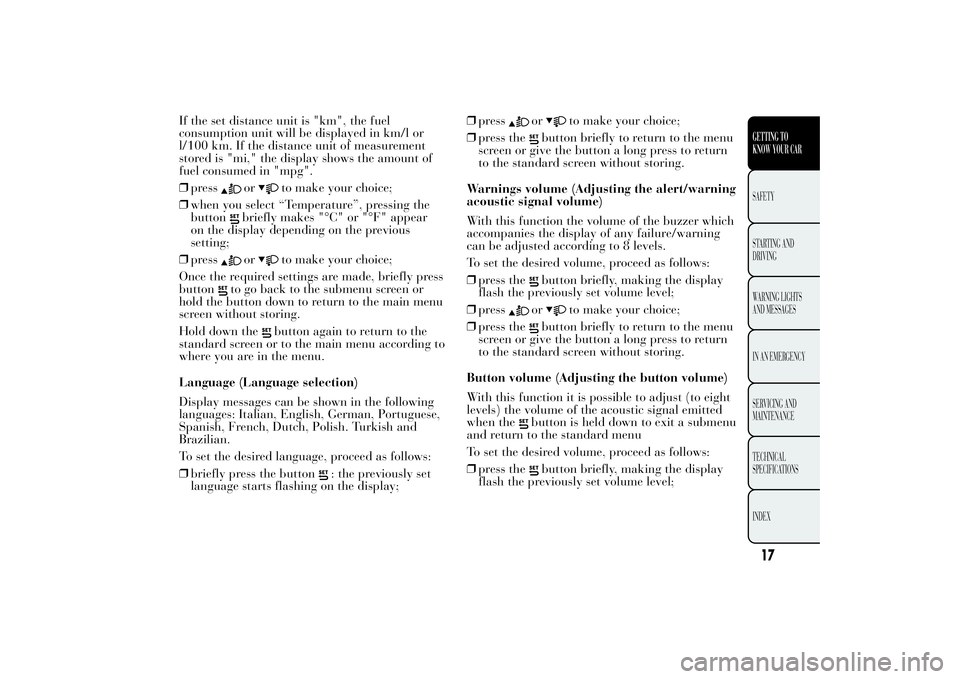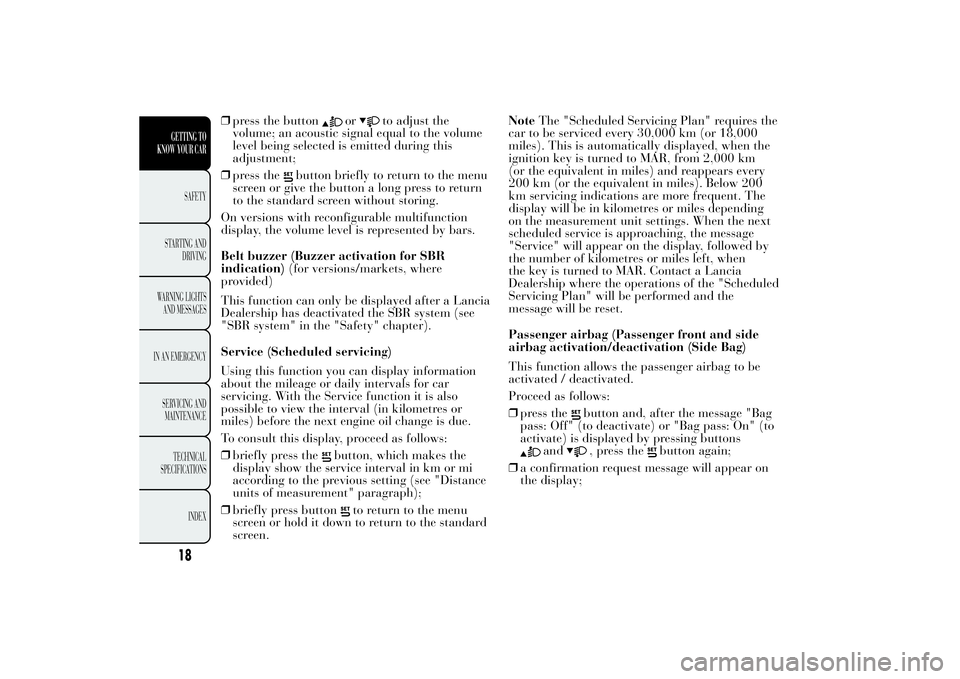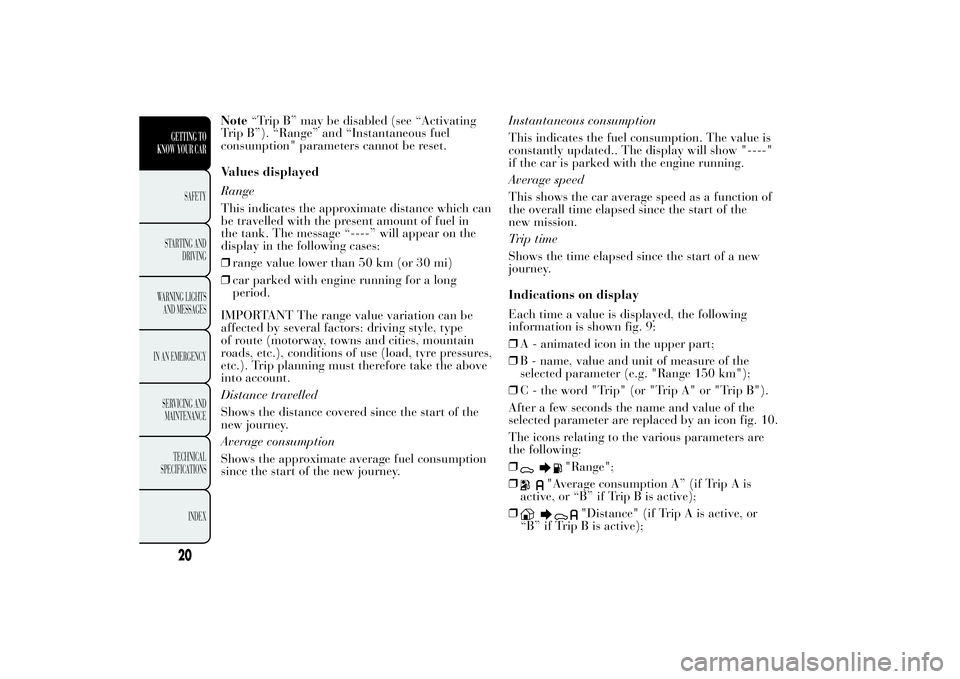display Lancia Ypsilon 2011 Owner handbook (in English)
[x] Cancel search | Manufacturer: LANCIA, Model Year: 2011, Model line: Ypsilon, Model: Lancia Ypsilon 2011Pages: 299, PDF Size: 13.35 MB
Page 18 of 299

To carry out the adjustment, proceed as follows:
❒briefly press
: "First page" will appear on the
display;
❒press the
button again briefly to display the
"Date" and "Trip distance" options;
❒briefly press
: the "Month" will flash on the
display;
❒press
or
to select the information you
wish to see on the main page of the display;
❒press the
button briefly to return to the menu
screen or give the button a long press to return
to the standard screen without storing.
When the key is turned to MAR and the initial
check stage is over, the display will show the
information selected via the "First page" menu
function.
Autoclose (automatic central locking with the
car in motion)
When activated (On), this function locks the doors
automatically when the vehicle speed exceeds 20
km/h.
Proceed as follows to activate or deactivate this
function:
❒press thebutton briefly to make the display
flash On or Off according to what was
previously set;
❒pressor
to make your choice;❒press the
button briefly to return to the
submenu screen or hold the button down to
return to the main menu screen without saving;
❒hold thebutton down again to return to
the standard screen or to the main menu
according to where you are in the menu.
Unit of measurement (Setting the unit of
measurement)
With this function it is possible to set the units
through three submenus: "Distances",
"Consumption" and "Temperature".
To set the desired measurement unit, proceed as
follows:
❒briefly press
to display the three submenus;
❒press buttonor
to navigate through the
three submenus;
❒once you have selected the submenu to be
changed, press the button
briefly;
❒when you select “Distances”, briefly pressing
the button
makes the display show "km"
or "mi" depending on the previous setting;
❒press
or
to select;
❒when you select “Consumption”, pressing
button
briefly makes "km/l", "l/100km" or
"mpg" appear on the display depending on
the previous setting;
16GETTING TO
KNOW YOUR CAR
SAFETY
STARTING
AND
DRIVING
WARNING LIGHTS
AND MESSAGES
IN AN EMERGENCY
SERVICING AND
MAINTENANCE
TECHNICAL
SPECIFICATIONS
INDEX
Page 19 of 299

If the set distance unit is "km", the fuel
consumption unit will be displayed in km/l or
l/100 km. If the distance unit of measurement
stored is "mi," the display shows the amount of
fuel consumed in "mpg".
❒press
or
to make your choice;
❒when you select “Temperature”, pressing the
button
briefly makes "°C" or "°F" appear
on the display depending on the previous
setting;
❒pressor
to make your choice;
Once the required settings are made, briefly press
button
to go back to the submenu screen or
hold the button down to return to the main menu
screen without storing.
Hold down the
button again to return to the
standard screen or to the main menu according to
where you are in the menu.
Language (Language selection)
Display messages can be shown in the following
languages: Italian, English, German, Portuguese,
Spanish, French, Dutch, Polish. Turkish and
Brazilian.
To set the desired language, proceed as follows:
❒briefly press the button
: the previously set
language starts flashing on the display;❒press
or
to make your choice;
❒press the
button briefly to return to the menu
screen or give the button a long press to return
to the standard screen without storing.
Warnings volume (Adjusting the alert/warning
acoustic signal volume)
With this function the volume of the buzzer which
accompanies the display of any failure/warning
can be adjusted according to 8 levels.
To set the desired volume, proceed as follows:
❒press thebutton briefly, making the display
flash the previously set volume level;
❒pressor
to make your choice;
❒press the
button briefly to return to the menu
screen or give the button a long press to return
to the standard screen without storing.
Button volume (Adjusting the button volume)
With this function it is possible to adjust (to eight
levels) the volume of the acoustic signal emitted
when thebutton is held down to exit a submenu
and return to the standard menu
To set the desired volume, proceed as follows:
❒press thebutton briefly, making the display
flash the previously set volume level;
17GETTING TO
KNOW YOUR CARSAFETY
STARTING
AND
DRIVING
WARNING LIGHTS
AND MESSAGES
IN AN EMERGENCY
SERVICING AND
MAINTENANCE
TECHNICAL
SPECIFICATIONS
INDEX
Page 20 of 299

❒press the button
or
to adjust the
volume; an acoustic signal equal to the volume
level being selected is emitted during this
adjustment;
❒press the
button briefly to return to the menu
screen or give the button a long press to return
to the standard screen without storing.
On versions with reconfigurable multifunction
display, the volume level is represented by bars.
Belt buzzer (Buzzer activation for SBR
indication)(for versions/markets, where
provided)
This function can only be displayed after a Lancia
Dealership has deactivated the SBR system (see
"SBR system" in the "Safety" chapter).
Service (Scheduled servicing)
Using this function you can display information
about the mileage or daily intervals for car
servicing. With the Service function it is also
possible to view the interval (in kilometres or
miles) before the next engine oil change is due.
To consult this display, proceed as follows:
❒briefly press the
button, which makes the
display show the service interval in km or mi
according to the previous setting (see "Distance
units of measurement" paragraph);
❒briefly press button
to return to the menu
screen or hold it down to return to the standard
screen.NoteThe "Scheduled Servicing Plan" requires the
car to be serviced every 30,000 km (or 18,000
miles). This is automatically displayed, when the
ignition key is turned to MAR, from 2,000 km
(or the equivalent in miles) and reappears every
200 km (or the equivalent in miles). Below 200
km servicing indications are more frequent. The
display will be in kilometres or miles depending
on the measurement unit settings. When the next
scheduled service is approaching, the message
"Service" will appear on the display, followed by
the number of kilometres or miles left, when
the key is turned to MAR. Contact a Lancia
Dealership where the operations of the "Scheduled
Servicing Plan" will be performed and the
message will be reset.
Passenger airbag (Passenger front and side
airbag activation/deactivation (Side Bag)
This function allows the passenger airbag to be
activated / deactivated.
Proceed as follows:
❒press the
button and, after the message "Bag
pass: Off" (to deactivate) or "Bag pass: On" (to
activate) is displayed by pressing buttons
and
, press the
button again;
❒a confirmation request message will appear on
the display;
18GETTING TO
KNOW YOUR CAR
SAFETY
STARTING
AND
DRIVING
WARNING LIGHTS
AND MESSAGES
IN AN EMERGENCY
SERVICING AND
MAINTENANCE
TECHNICAL
SPECIFICATIONS
INDEX
Page 21 of 299

❒by pressing the
or
buttons select "Yes"
(to confirm activation/deactivation) or "No"
(to cancel);
❒press the
button briefly; a message confirming
the selection is displayed and you return to the
menu screen; Hold down the button to return to
the standard screen without storing.
Exit menu
This function closes the cycle of settings listed in
the menu screen. Pressing the
button briefly will
return the display to the standard screen without
storing. Press button
to return to the first
menu item (Speed Beep).
TRIP COMPUTERGeneral information
The Trip computer is used to display information
on car operation when the key is turned to
MAR-ON. This function allows you to define two
separate trips, called “Trip A” and “Trip B”,
for monitoring the car's "complete mission"
(journey) in a reciprocally independent manner.
Both functions are resettable (reset - start of a new
journey).
“Trip A” is used to display the figures relating to:
❒Outside temperature (for LPG/Natural Power
versions equipped with multifunction display)
❒Range
❒Distance travelled
❒Average consumption
❒Instantaneous consumption
❒Average speed
❒Trip time (driving time).
“Trip B” may be used to display the figures
relating to:
❒Distance travelled B
❒Average consumption B
❒Average speed B
❒Trip time B (driving time).
19GETTING TO
KNOW YOUR CARSAFETY
STARTING
AND
DRIVING
WARNING LIGHTS
AND MESSAGES
IN AN EMERGENCY
SERVICING AND
MAINTENANCE
TECHNICAL
SPECIFICATIONS
INDEX
Page 22 of 299

Note“Trip B” may be disabled (see “Activating
Trip B”). “Range” and “Instantaneous fuel
consumption" parameters cannot be reset.
Values displayed
Range
This indicates the approximate distance which can
be travelled with the present amount of fuel in
the tank. The message “----” will appear on the
display in the following cases:
❒range value lower than 50 km (or 30 mi)
❒car parked with engine running for a long
period.
IMPORTANT The range value variation can be
affected by several factors: driving style, type
of route (motorway, towns and cities, mountain
roads, etc.), conditions of use (load, tyre pressures,
etc.). Trip planning must therefore take the above
into account.
Distance travelled
Shows the distance covered since the start of the
new journey.
Average consumption
Shows the approximate average fuel consumption
since the start of the new journey.Instantaneous consumption
This indicates the fuel consumption. The value is
constantly updated.. The display will show "----"
if the car is parked with the engine running.
Average speed
This shows the car average speed as a function of
the overall time elapsed since the start of the
new mission.
Trip time
Shows the time elapsed since the start of a new
journey.
Indications on display
Each time a value is displayed, the following
information is shown fig. 9:
❒A - animated icon in the upper part;
❒B - name, value and unit of measure of the
selected parameter (e.g. "Range 150 km");
❒C - the word "Trip" (or "Trip A" or "Trip B").
After a few seconds the name and value of the
selected parameter are replaced by an icon fig. 10.
The icons relating to the various parameters are
the following:
❒
"Range";
❒
"Average consumption A” (if Trip A is
active, or “B” if Trip B is active);
❒
"Distance" (if Trip A is active, or
“B” if Trip B is active);
20GETTING TO
KNOW YOUR CAR
SAFETY
STARTING
AND
DRIVING
WARNING LIGHTS
AND MESSAGES
IN AN EMERGENCY
SERVICING AND
MAINTENANCE
TECHNICAL
SPECIFICATIONS
INDEX
Page 23 of 299

❒
"Instantaneous consumption";
❒"Average speed A” (if Trip A is active, or
“B” if Trip B is active);
❒"Trip time" (if Trip A is active, or “B” if
Trip B is active);TRIP BUTTON
This is located on the right-hand stalk fig. 11.
With the ignition key turned to MAR, this button
allows you to view the previously described
parameters and also reset them to begin a new
mission:
❒short press: display various readings;
❒long press: reset readings and start a new
mission.
New mission
This begins after a reset:
❒“manual” resetting by the user, by pressing the
relevant button;
❒“automatic” resetting, when the “Trip distance”
reaches 9999.9 km or when the “Travel time”
reaches 99:59 (99 hours and 59 minutes);
❒after disconnection/reconnection of the battery.
fig. 9
L0F1009
fig. 10
L0F0032
fig. 11
L0F0079
21GETTING TO
KNOW YOUR CARSAFETY
STARTING
AND
DRIVING
WARNING LIGHTS
AND MESSAGES
IN AN EMERGENCY
SERVICING AND
MAINTENANCE
TECHNICAL
SPECIFICATIONS
INDEX
Page 24 of 299

IMPORTANT The reset operation when “Trip A”
or “Trip B” details are being displayed resets
the information associated with the function
displayed.
Start of journey procedure
With ignition key at MAR, press and hold the
TRIP button for more than 2 seconds to reset.
Exit Trip
You can automatically exit the TRIP function once
all the values have been displayed or by holding
the button
down for more than 1 second.
SYMBOLSSome car components have coloured labels whose
symbols indicate precautions to be observed
when using this component. Under the bonnet
there is also a label that summarises all the
symbols.
22GETTING TO
KNOW YOUR CAR
SAFETY
STARTING
AND
DRIVING
WARNING LIGHTS
AND MESSAGES
IN AN EMERGENCY
SERVICING AND
MAINTENANCE
TECHNICAL
SPECIFICATIONS
INDEX
Page 27 of 299

Unlocking the doors and the tailgate
Briefly press button
: for unlocking of doors and
luggage compartment, timed switching-on of
internal roof lights and double flashing of
direction indicators (for versions/markets, where
provided).
Door lock is automatically released if the fuel
cut-off system trips.
Once the doors are locked, if one or more doors or
the boot are not closed correctly, the LED and
direction indicators start flashing quickly.
Locking the doors and the tailgate
Briefly press button: for locking of doors and
luggage compartment, with switching-off of roof
light and single flashing of direction indicators
(for versions/markets, where provided).If one or more doors are open, the doors will not
be locked. This is indicated by a rapid flashing of
the direction indicators (for versions/markets,
where provided). The doors are locked if the
luggage compartment is open
When a speed of over 20 km/h is reached, the
doors are automatically locked if this specific
function has been set (only on versions with
multi-function reconfigurable display).
When the doors are locked from outside the car
(using the remote control), A LED above the
button will switch on for a few seconds and
then start flashing (deterrent function).
When the doors are locked from inside the car (by
pressing the
button) the LED will remain on
constantly.
Opening the luggage compartment
Press thebutton to open the luggage
compartment using the remote control.
The direction indicators will flash twice to indicate
that the luggage compartment has been opened.
The electronic components inside the
key may be damaged if the key is
subjected to strong shocks. In order to
ensure complete efficiency of the electronic
devices inside the key, it should never be
exposed to direct sunlight.
fig. 14
L0F0075
25GETTING TO
KNOW YOUR CARSAFETY
STARTING
AND
DRIVING
WARNING LIGHTS
AND MESSAGES
IN AN EMERGENCY
SERVICING AND
MAINTENANCE
TECHNICAL
SPECIFICATIONS
INDEX
Page 42 of 299

+
distribution between feet area diffusers
(warmest air) and dashboard vents
(coolest air).
+
distribution between feet area diffusers
and windscreen/front side window
diffusers. This type of distribution
achieves effective heating of the
passenger compartment and prevents
the windows from misting up.
Button B MAX
- MAX-DEF function
activation
When theMAXbutton
is pressed, the system
activates all the functions required for fast
demisting/defrosting, that is:
❒compressor on (if the weather conditions are
suitable)
❒air recirculation off
❒maximum air temperature setting (HI)
❒fan speed determined according to the coolant
temperature
❒air flow conveyed to the windscreen and front
side windows
❒Button C
- Climate control compressor
activation/deactivation
When the button is pressed, the compressor is
deactivated.
When the compressor is deactivated:
❒the system will deactivate air recirculation to
prevent the windows from misting up;❒it is not possible to convey air to the passenger
compartment with a temperature below the
outside temperature (the temperature indicated
on the display will flash when the system cannot
guarantee the required comfort conditions);
❒the fan speed can be manually reset (with
compressor enabled, ventilation cannot go
below a bar shown on the display).
Button D
- Internal air recirculation
on/off
It is advisable to switch the internal air
recirculation on whilst queuing or in tunnels to
prevent the introduction of polluted air.
At low temperatures or if the compressor is off,
the recirculation is forced to off to prevent
misting.
IMPORTANT It is inadvisable to use air
recirculation when the outside temperature is low,
since the windows could mist rapidly.
Button E (AUTO) - AUTO function activation
(automatic climate control operation)
When the AUTO button is pressed and the
required temperature is set, the system adjusts air
temperature, quantity and distribution into the
passenger compartment and manages the
activation of the compressor.
40GETTING TO
KNOW YOUR CAR
SAFETY
STARTING
AND
DRIVING
WARNING LIGHTS
AND MESSAGES
IN AN EMERGENCY
SERVICING AND
MAINTENANCE
TECHNICAL
SPECIFICATIONS
INDEX
Page 43 of 299

Button F
- Heated rear window activation/
deactivation
When button
is pressed, the LED on the button
switches on.
Buttons G
- Fan speed adjustment
Button H (OFF) - Climate control activation/
deactivation
When the OFF button is pressed, the system is
deactivated.
With the system off, the climate control system
conditions are as follows:
❒all LEDs are off;
❒set temperature display is off;
❒air recirculation is off;
❒compressor is off;
❒fan is off.
Button I - Air temperature increase
When the button is pressed, the passenger
compartment air temperature increases.
Button L - Air temperature decrease
When the button is pressed, the passenger
compartment air temperature decreases.DESCRIPTION
The automatic climate control allows
the driver side air temperature and passenger side
air temperature to be adjusted separately.
The system has an AQS function (Air Quality
System), which automatically activates internal
air recirculation when the outside air is polluted
(e.g. in traffic queues and tunnels).
The automatically controlled parameters and
functions are:
❒air temperature at the driver/front passenger
side vents
❒air distribution at the driver/front passenger
side vents
❒fan speed (continuous variation of the air flow)
❒compressor activation (for cooling/
dehumidifying the air)
❒air recirculation.
All functions may be changed manually. In other
words, you may select one or more functions
and change the parameters as required. Automatic
control of the manually changed functions will
be suspended: the system will only override your
settings for safety-related reasons (e.g. risk of
misting).
41GETTING TO
KNOW YOUR CARSAFETY
STARTING
AND
DRIVING
WARNING LIGHTS
AND MESSAGES
IN AN EMERGENCY
SERVICING AND
MAINTENANCE
TECHNICAL
SPECIFICATIONS
INDEX